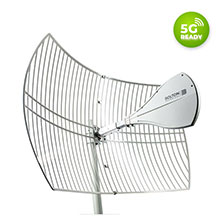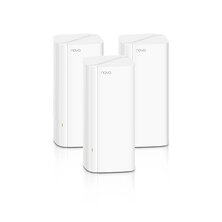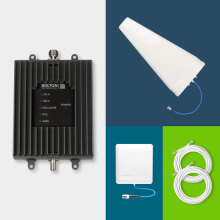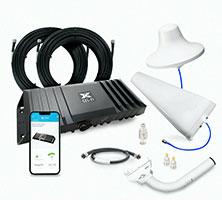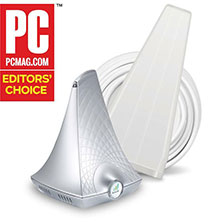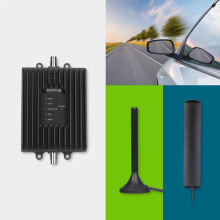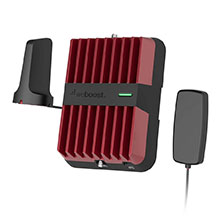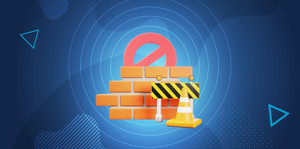How to Tell if A Cell Phone Booster Will Work for You
So, you’ve heard a cell phone signal booster can help rid your life of dropped calls, delayed texts, and slow data. Great! This is true for most people.
But wait. When you researched how a signal booster works, you learned they didn’t work in every case. Now you’re potentially looking at a costly investment that might not even work!
Don’t worry. We walk people through these scenarios all the time. Below, you’ll find the most common. If you’re still not sure whether a booster will work for you, give us a call at 1-800-470-6777 for a toll-free consultation. Now, let’s get started.
Take advantage of our system design and installation services. Learn more or call us for a free consultation: 1-800-969-8189.
Cell Phone Boosters Will Work for You If:
1) Usable Cellular Signal is Available Outside Your Home or Vehicle
Cell phone signal boosters amplify existing 5G, 4G, and LTE signals. They do not manifest reliable cellular signals out of thin air. Thus, cellular signal must be present OUTSIDE your home, office, or vehicle for a booster to do its thing.
Don’t trust your phone’s signal bars to determine if you have usable cell signal. They are subjective across carriers and devices. Instead, measure your cellular signal strength using decibel-milliwatts (dBm). Visit, “How to Get Exact Signal Readings” to learn how.
If you find that you have some signal while outdoors, a signal booster will work for you. Whatever’s blocking the signal from reaching your devices won’t be an issue anymore. You’ll have reliable cellular reception wherever you need it – in certain rooms or throughout your entire home.
The stronger the signal outside, the wider the coverage you’ll receive. If you’re a victim of poor outside reception, a more powerful signal booster with specialized donor antennas may be needed to see a significant difference. We recommend the Bolton Long Ranger for that, as it can reach cell towers up to 20 miles away.
Bolton Technical Long Ranger
- Directional with a 10° radiation beam
- Offers up to +28 dBi gain
- Capable of reaching towers 20 miles away
- Compatible with 50 Ohm in-building signal boosters, or 75 Ohm units with adapter
- Ideal for rural communities in extremely weak signal areas
2) You Can Get Enough Space Between the Indoor and Outdoor Antennas
All cell boosters are kitted with two cellular antennas. The outdoor antenna pulls in cell signals from your nearest cell towers and the indoor antenna broadcasts the signal. For optimal performance, the antennas must be installed a certain distance from each other.
If they’re installed too close, it can lead to oscillation or cause the booster to shut down. As a result, you won’t get the signal you need to boost talk, text, and data.
If you’re installing a home or in-building booster, you ideally want 20 ft vertical or 50 ft horizontal between the two antennas.
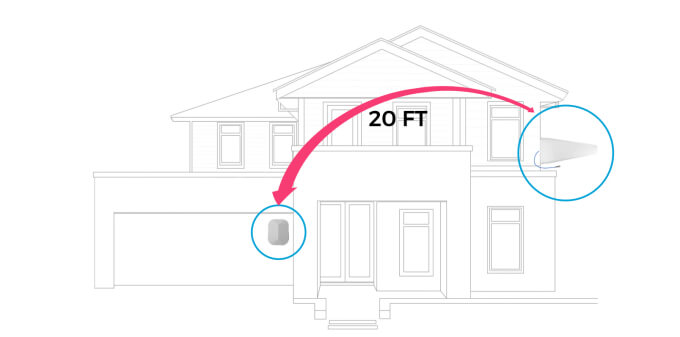
This varies by signal booster manufacturer. Refer to the unit’s manual for antenna distance requirements. If said distance isn’t possible, a combination of vertical and horizontal separation will work. Those with weak outside signals may get away with less separation.
For vehicle boosters, you want about 5 ft of separation between the two antennas.
3) You Have Rough Material That Blocks Cell Service
Buildings and vehicles are not designed with cell phone signal coverage in mind. They are designed for sturdiness and safety. Almost everything that keeps buildings and vehicles intact has the power to turn your space into a dead zone. Such materials include metal, aluminum, concrete, tinted glass, brick, plywood, and more. Here is a list of building materials that block cell phone signals and by how much.
If you have existing cell signal outside and notice it instantly degrades as soon as you step foot inside, building material is to blame. With the use of coaxial cables, cell phone signal boosters can definitely help bypass signal-blocking material and blanket your space with reliable reception.
4) You Want Faster Cellular Data Via a Cellular Router or Hotspot
Fast internet connectivity from a cellular router or hotspot depends on a strong cellular connection. By improving your in-building or in-vehicle cell coverage with a signal booster, cellular routers and hotpots also benefit. They’re not just designed to amplify cell signals for cell phones. They work with all cellular-enabled devices, including cellular routers and hotspots.
When at the edge of your carrier's coverage, you’ll no longer have to struggle to access the internet for work or play.
5) You Want to Improve Your In-Building or In-Vehicle Coverage
Whether you want to improve weak coverage or eliminate dead spots indoors, a signal booster is the right man for the job. They are exclusively designed for indoor use.
The indoor antenna broadcasts the boosted signal anywhere you need. Coverage will depend on how strong your outside signal is. To maximize coverage multiple indoor cellular antennas may be needed, especially for multi-story buildings.
Cell Phone Boosters Will Not Work for You If:
There is No Existing Cell Signal
For a cell phone booster to work, it NEEDS cell signal. If you have no service outside your home or on the road, a booster can’t help you. Though, sometimes available signal is too weak for your phone to pick up. Thus, it’s important to measure your cellular signal strength to determine how weak your cell signal is.
You're Trying to Boost Cell Signal Outside
While it’s convenient to have reliable cell reception outside, signal boosters do not work outdoors. They use the walls to propagate boosted signal throughout. If installed outdoors, the signal has nothing to bounce off and can interfere with nearby cell towers.
You’re Trying to Boost Broadband Internet
Like cell signal, spotty or slow internet in certain areas is common. Signal boosters will not improve your broadband internet's performance. They only enhance cellular connectivity. What you need is a WiFi range extender or mesh network.
Tenda EX12 AX3000 Whole Home Mesh WiFi 6 System
- Three pack mesh network system
- Blankets up to 7,000 sq ft with WiFi 6
- Supports up to 160 devices
- Seamless connectivity throughout
- Supports dual-band concurrent speeds up to 3000 Mbps
What Cell Phone Boosters Actually Do
Now that you know that a signal booster will work for you, here is what you can expect:
- Better Carrier Agnostic or Carrier Specific Coverage – There are two types of cell phone boosters: single-carrier and multi-carrier. With carrier-specific units, like those from Cel-Fi, you’ll receive a much bigger boost and better coverage for one carrier at a time. Multi-carrier boosters, like those from weBoost, SureCall, HiBoost, and Uniden, provide a weaker boost but cover all carriers at once.
- Increased Connectivity for All Cellular Devices – Signal boosters do not discriminate. They enhance cell reception for all cellular-enabled devices within their coverage area. That includes iPhones, Androids, tablets, iPads, cellular routers, cellular hotspots, and more.
- Little to No Dropped Calls – Dropped calls are a sign of an unstable connection between your cell phone and the cell tower. A signal booster strengthens that connection, allowing your devices to receive a more stable signal. Dropped calls will be a thing of the past or rarely occur.
- Improved Data Speeds – Spotty and slow mobile data are the result of poor cell reception. By enhancing cell signals, mobile data reliability also improves for all cellular devices. Apps, webpages, movies, music, and video calls will finally load smoothly
Here are our top cell phone signal boosters:
Best Home Signal Booster Kits
Bolton Victory Yagi/Panel Cellular Signal Booster
Overview of the Bolton Victory Yagi/Panel:
- For Small to Medium Size Homes and Offices
- Covers Up to 4,000 Sq Ft
- Up to +72 dB Gain
- Up to 26 dBm Uplink Power
- Supports All Carriers Simultaneously
The Bolton Victory Yagi/Panel cellular booster is our top pick for rural areas. Under optimal conditions, it can blanket up to 4,000 sq ft with stronger cell reception, which is more than enough for most people. Featuring up to 26 dBm uplink and up to 72 dB gain, it has incredible reach and can significantly amplify your existing weak cellular signal.
Strategically paired with the Bolton Quicksilver Outdoor Yagi Antenna, it works wonders in remote locations. This antenna is designed to draw in signals from cell towers up to 5 miles away. Distance from the signal source will no longer be a problem.
While capable of boosting multiple carriers at the same time, you may only receive improved cell reception from one or two carriers. This is because the antenna is directional and needs to point at the closest cell tower that’s powered by your preferred carrier. If boosting multiple carriers is more important than coverage area, consider the Bolton Velocity Omni/Panel Cellular Signal Booster.
| Pros: | Cons: |
|
|
Cel-Fi by Nextivity GO X
Overview of the Cel-Fi GO X:
- For Large Homes and Offices
- Covers Up to 15,000 Sq Ft
- Up to +100 dB Gain
- Amplifies One Carrier at a Time
The GO X by Nextivity is the most powerful cell phone signal booster for remote areas available. It’s designed with up to 100 dB gain, the highest on the market. This unit can seriously make all your signal woes disappear. The caveat is that it can only boost one carrier at a time. Though, through the Cel-Fi WAVE app, you’re able to switch between carriers as you need.
Super customizable, you have multiple outdoor antenna options to really maximize the amplifier's reach to your closest cell tower. You can reach cell towers located up to 5 miles away with the Quicksilver Yagi, up to 10 miles away with the Bolton Arrow LPDA, or up to 20 miles away with the Bolton Long Ranger. No matter how weak your cellular reception is, any of these configurations will keep you connected, that is unless you’re in a total dead zone.
Rated to cover up to 15,000 sq ft, it's best for large homes and small businesses. Indoor coverage will vary based on the strength of your outside signal.
| Pros: | Cons: |
|
|
SureCall Flare 3.0
Overview of SureCall Flare 3.0:
- For Small Homes or Spot Coverage
- Covers Up to 3,000 Sq Ft
- Up to +72 dB Gain
- Up to 26 dBm Uplink
- Supports All Carriers Simultaneously
- 2-in-1 Amplifier/Indoor Antenna Combo for Ease of Installation
The SureCall Flare 3.0 cellular booster packs a signal punch for the price. It includes a Yagi antenna, which is ideal for rural areas, and a sleek amplifier. The indoor antenna is built into the amplifier, making the Flare 3.0 one of the easiest units to install yourself.
With up to 72 dB gain and 26 dBm uplink, it offers good amplification and reach to distant cell towers for a booster of its kind. While power is similar to that of the Bolton Victory, the Flare 3.0 offers less coverage and a less powerful Yagi antenna. It’s rated to cover 3,000 sq ft, but will likely only provide multi-room to spot coverage.
| Pros: | Cons: |
|
|
Best Cell Phone Boosters for Vehicles
Bolton Velocity Vehicle
Overview of the Velocity Vehicle:
- For Cars, Trucks, and RVs
- Up to 50 dB Gain
- Support Multiple Carriers Simultaneously
- Easy Install
The Velocity Vehicle is carefully crafted to keep drivers and passengers connected in the most difficult environments. It’s built with the highest gain and uplink. No matter where you drive, as long as there is a sliver of cellular signal, the Velocity Vehicle will keep all devices connected.
This particular model comes with a magnet mount antenna, making it ideal for your everyday cars, SUVs, and trucks. Installation is a breeze. For semis and heavier-duty trucks, consider the Velocity Trucker. It includes a tough OTR outside antenna featuring great reach, heavy-duty construction, and whistle-free wrap.
| Pros: | Cons: |
|
|
weBoost Drive Reach
Overview of the weBoost Drive Reach:
- For RVs, Cars, Trucks, and Boats
- Up to 50 dB Gain
- Support Multiple Carriers Simultaneously
- Easy Install
The weBoost Drive Reach is weBoost’s most powerful in-vehicle cell signal booster for cars, SUVs, trucks, and minivans. Features increased uplink than previous generations, users can get signal that is 2x farther from towers for twice the signal strength. Dropping calls and losing navigation connection will all be a thing of the past while driving on remote roads or highways.
Cellular antennas will vary depending on the Drive Reach configuration that best meets your needs.
We wouldn't recommend anything weaker than the Drive Reach for rural areas.
| Pros: | Cons: |
|
|
If you need help finding the best signal booster for your needs give us a call at 1-800-470-6777 or email us at sales@signalboosters.com. We’re here to help you get the signal you want anywhere you need it!
Interested in Learning More? Check Out Our Cellular Info Hub / WiFi Info Hub


